German Influences on American Economic Thought and American Influences on German Economic Thought

BOOK
Cite BOOK
Style
Format
German Influences on American Economic Thought and American Influences on German Economic Thought
Deutsche Einflüsse auf amerikanisches wirtschaftswissenschaftliches Denken und amerikanische Einflüsse auf deutsches Wirtschaftsdenken. Studien zur Entwicklung der ökonomischen Theorie XXXII
Editors: Hagemann, Harald
Schriften des Vereins für Socialpolitik, Vol. 115/XXXII
(2017)
Additional Information
Book Details
Abstract
Im Zentrum der neun Beiträge stehen die wechselseitigen Einflüsse zwischen dem deutschen und dem amerikanischen wirtschaftswissenschaftlichen Denken. Während die Entwicklung in den Wirtschaftswissenschaften nach dem Zweiten Weltkrieg durch eine zunehmende Internationalisierung gekennzeichnet ist, die in hohem Maße zugleich eine Amerikanisierung ist, war der Wissenstransfer über den Nordatlantik insbesondere zwischen 1871 und dem Ersten Weltkrieg weitgehend in umgekehrter Richtung verlaufen. Eine entscheidende Ursache der Schwerpunktverschiebung liegt in der Zeit des Nationalsozialismus, in der die USA auch in der Volkswirtschaftslehre zum wichtigsten Aufnahmeland für verfolgte und emigrierte Wissenschaftler aus Deutschland und Österreich wurden. Charakteristisch für die zunehmende Dominanz amerikanisch geprägter Wirtschaftstheorie nach 1945 ist der Einfluss der monetaristischen (Gegen-)Revolution auf Geldtheorie und Geldpolitik in den 1970er Jahren.The focus of the nine contributions is on the mutual influences between German and American economic thought. Whereas in the period between 1871 and 1914 the Humboldtian research university was a main attractor for younger American scientists who went to Germany for (post-) graduate studies, WW I and particularly the Nazi period contributed to a decisive shift in the direction of the transfer of knowledge in economics. Émigré economists from Germany and Austria made major contributions to the »Americanization« of economics after WW II.
